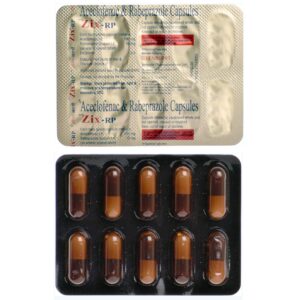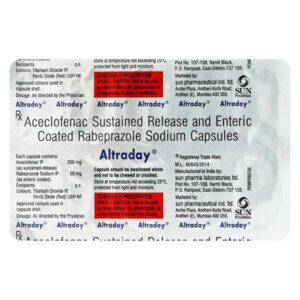ACECLOFENAC + RABEPRAZOLE
Aceclofenac: Aceclofenac is a non-steroidal anti-inflammatory drug (NSAID) that is used to relieve pain and inflammation in various conditions such as osteoarthritis, rheumatoid arthritis, and ankylosing spondylitis. It belongs to the class of phenylacetic acid derivatives.
The mechanism of action of aceclofenac is through the inhibition of cyclooxygenase enzymes, specifically COX-1 and COX-2. These enzymes are responsible for the synthesis of prostaglandins that are associated with pain and inflammation. By inhibiting these enzymes, aceclofenac reduces the production of prostaglandins, leading to pain relief and reduced inflammation.
Aceclofenac is typically taken orally, in tablet form, with or after meals. The recommended dose for adults is usually 100 mg, taken twice daily. The dosage may vary depending on the severity of the condition and individual response, so it is important to follow the instructions given by a healthcare professional.
As with any medication, aceclofenac can have side effects. Common side effects may include nausea, vomiting, heartburn, indigestion, diarrhea, abdominal pain, dizziness, headache, and changes in liver function tests. In rare cases, more serious side effects such as gastrointestinal bleeding, ulceration, allergic reactions, skin rash, and liver toxicity have been reported. It is important to consult a healthcare professional if any side effects are experienced or if there are any concerns about the medication.
It should be noted that aceclofenac is not recommended for use in individuals with a history of allergic reactions to NSAIDs, asthma, peptic ulcer disease, severe heart failure, or those who are in the third trimester of pregnancy. It is always advisable to discuss the use of aceclofenac with a healthcare professional to ensure it is appropriate for the individual’s specific condition and medical history.
Rabeprazole: Rabeprazole is a medication used to treat conditions caused by excessive stomach acid production, such as gastroesophageal reflux disease (GERD), peptic ulcers, and Zollinger-Ellison syndrome. It belongs to a class of drugs known as proton pump inhibitors (PPIs).
The mechanism of action of rabeprazole involves blocking the action of the proton pumps in the stomach’s cells. These pumps are responsible for producing acid, so by inhibiting their activity, rabeprazole reduces the amount of acid produced, providing relief from acid-related symptoms.
Rabeprazole is typically taken orally, usually once a day, before a meal. The dose and duration of treatment depend on the specific condition being treated and the individual’s response to the medication. It is important to follow the prescribed dosage and duration of treatment as directed by a healthcare professional.
While generally well-tolerated, rabeprazole can cause certain side effects. Common side effects may include headache, diarrhea, nausea, stomach pain, flatulence, and constipation. These side effects are usually mild and temporary.
Rare but more serious side effects that require immediate medical attention include severe abdominal pain, persistent vomiting, chest pain, difficulty swallowing, unexplained weight loss, and black/tarry stools.
It is essential to inform a healthcare professional about any existing medical conditions and medications being taken before starting rabeprazole to ensure its safe and effective use. Long-term use of PPIs like rabeprazole may increase the risk of certain complications, such as bone fractures, vitamin B12 deficiency, and infection.
Overall, rabeprazole is a widely used medication for managing conditions caused by excess stomach acid production. However, it is important to use it under the supervision of a healthcare professional and report any concerning side effects promptly.


